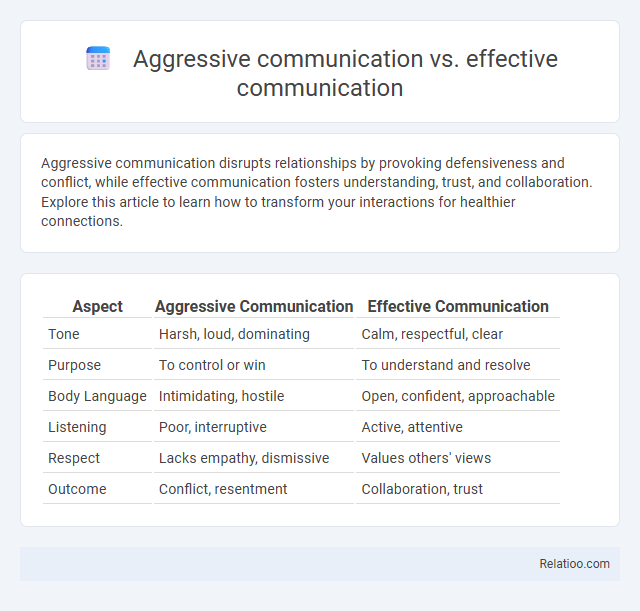Aggressive communication disrupts relationships by provoking defensiveness and conflict, while effective communication fosters understanding, trust, and collaboration. Explore this article to learn how to transform your interactions for healthier connections.
Table of Comparison
| Aspect | Aggressive Communication | Effective Communication |
|---|---|---|
| Tone | Harsh, loud, dominating | Calm, respectful, clear |
| Purpose | To control or win | To understand and resolve |
| Body Language | Intimidating, hostile | Open, confident, approachable |
| Listening | Poor, interruptive | Active, attentive |
| Respect | Lacks empathy, dismissive | Values others' views |
| Outcome | Conflict, resentment | Collaboration, trust |
Understanding Aggressive Communication
Aggressive communication involves expressing your thoughts and feelings in a forceful, hostile, or disrespectful manner, often disregarding others' rights and emotions. Understanding aggressive communication helps you recognize behaviors such as interrupting, blaming, or shouting, which can damage relationships and escalate conflicts. Effective communication prioritizes clear, empathetic dialogue that respects all parties, fostering mutual understanding and collaboration rather than confrontation.
Defining Effective Communication
Effective communication is the clear and respectful exchange of information that ensures your message is understood and fosters positive relationships. Aggressive communication, characterized by hostility and domination, often leads to conflict and misunderstanding, while passive communication involves withholding thoughts or feelings, which can cause frustration. Mastering effective communication enhances your ability to convey ideas confidently without alienating others.
Key Differences Between Aggressive and Effective Communication
Aggressive communication involves dominating conversations, using threats, or blaming others, which often leads to conflict and damaged relationships, whereas effective communication emphasizes clear, respectful dialogue that ensures mutual understanding and cooperative problem-solving. Your ability to recognize these differences allows you to foster positive interactions by expressing needs firmly without violating others' rights. Key distinctions include tone, intent, and listening skills, where effective communication prioritizes empathy and constructive feedback, while aggressive communication is marked by hostility and disregard for others' perspectives.
Traits of Aggressive Communicators
Aggressive communicators exhibit traits such as domination, hostility, and a refusal to consider others' perspectives, often resulting in conflicts and damaged relationships. Your interactions may be perceived as confrontational or disrespectful, which hinders productive dialogue and collaboration. Understanding these traits helps differentiate aggressive communication from effective communication, which emphasizes clarity, respect, and active listening to foster positive outcomes.
Characteristics of Effective Communicators
Effective communicators exhibit active listening, empathy, and clarity, enabling them to convey messages respectfully and understand others' perspectives. They maintain a calm tone, use positive body language, and adapt their approach to suit the audience, ensuring mutual respect and productive dialogue. Your communication becomes more impactful when patience and openness replace aggression, fostering cooperation rather than conflict.
The Impact of Aggressive Communication in the Workplace
Aggressive communication in the workplace often leads to decreased employee morale, increased conflict, and reduced collaboration, significantly harming overall productivity and team cohesion. Unlike effective communication, which fosters understanding, respect, and problem-solving, aggressive communication creates a hostile environment that can escalate tensions and contribute to high turnover rates. Understanding the distinctions between these communication styles is essential for leaders aiming to cultivate a positive and efficient organizational culture.
Benefits of Practicing Effective Communication
Effective communication enhances clarity and fosters mutual understanding, leading to stronger relationships and increased productivity. Unlike aggressive communication, which often causes conflict and resentment, effective communication encourages active listening and empathy, promoting a collaborative environment. Practicing effective communication reduces misunderstandings and improves problem-solving skills, benefiting both personal and professional interactions.
Common Examples of Aggressive vs. Effective Communication
Common examples of aggressive communication include yelling, interrupting others, and using accusatory language that can create conflict and harm relationships. In contrast, effective communication involves active listening, using clear and respectful language, and expressing thoughts assertively without infringing on others' rights. Aggressive communication often escalates misunderstandings, while effective communication fosters understanding and collaboration.
Strategies to Shift from Aggressive to Effective Communication
Shifting from aggressive to effective communication requires mastering active listening and expressing your thoughts with clarity and respect. You can practice using "I" statements to take ownership of your emotions, reducing defensiveness and fostering collaborative dialogue. Consistently managing your tone and body language helps create a positive environment where your message is received without hostility.
Building a Positive Communication Culture
Aggressive communication often creates barriers and fosters hostility, undermining trust and collaboration within teams. Effective communication emphasizes clarity, empathy, and active listening, promoting mutual respect and understanding that strengthen relationships. Building a positive communication culture relies on consistent practice of assertiveness and feedback, encouraging openness and constructive dialogue.

Infographic: Aggressive communication vs Effective communication
 relatioo.com
relatioo.com